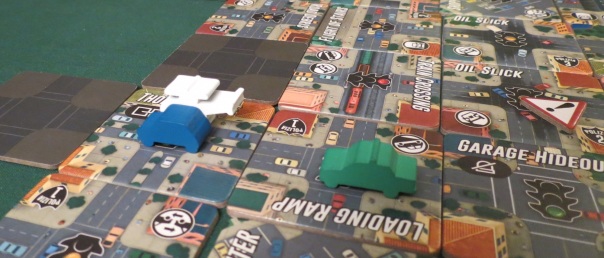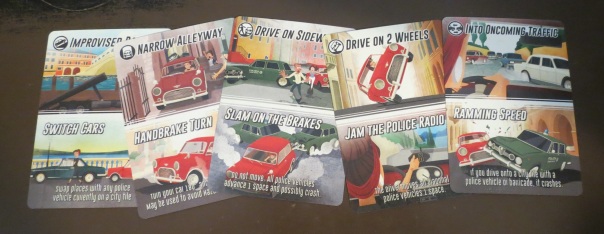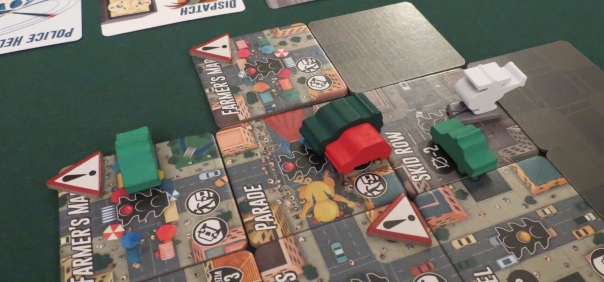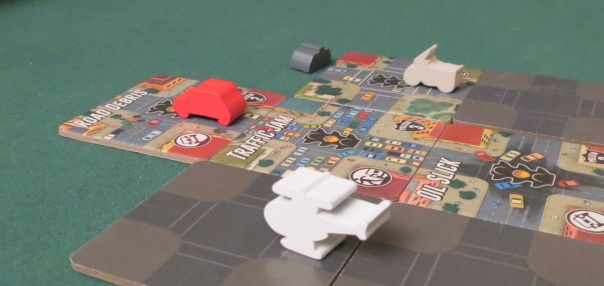I Drive
Getaway Driver would benefit from a soundtrack of frenetic jazz. Asymmetry is all the rage this year, but few games embrace it quite as wholeheartedly as Jeff Beck’s game of cat and mouse and cat and cat and cat — which seems dire until you realize that this particular mouse is riding five hundred horsepower and knows this city by heart. In other words, it’s free-form, kinetic, and apart from a few minor stutters, a real treat of asymmetric design.
This is the part where I normally tell you what Getaway Driver is about, but if you know anything about the Best Ways to Use Cars, you already know that “fleeing the police,” “riding it like you stole it,” and “chasing robbers” are the top three entries, so I’ll assume you understand. One player is a driver with gas and rubber to spare, the other is a city-wide dragnet bent on catching the driver. Gasoline and fireworks. Cue the mayhem.
That’s the setup. But the beauty of whole thing is that it’s two very different games welded almost seamlessly into a single double-decker, without becoming quite the monstrosity you might expect. And this goes both for the game’s mechanisms, which we’ll talk about in a moment, and its thematic side. Where the driver’s role is immediate, reactive, and largely tactical, the cops are deliberate, somewhat blundering, and entirely strategic. And those behaviors are codified directly into the actions both sides take on a turn by turn basis.
So let’s talk about those actions.
The first thing you need to know is that Getaway Driver might look a little sparse at the outset. You have a single tile with the getaway car on it, a few duffel bags strewn around the table, and a single patrol car a couple of inches away from the driver. This marks it as a “real space” game, in which the contours and obstacles of your playing surface are the map itself, with the blank table acting as the possibility space beyond the boundaries of the streets you’ve already seen. If you hit the edge of the table, there’s no scooting everything over — that’s the edge of the world as far as you’re concerned, as impassable as falling two hundred meters and rolling under a giant’s couch.
From that slight setup, the city swiftly blossoms outward. Every turn opens with the police adding up to three face-down tiles in the directions the driver can travel — forward, left, and right, with reverse being all but impossible given the velocity of this particular chase. Perhaps that makes the driver’s initial decisions seem slim. Forward, left, or right. There you go. Except there’s more to it, especially once the chase heats up.
First of all, the driver has the option of peeking at a nearby tile. Driving cautiously, as it were, to scout out the conditions of the road. But poking around in the middle of a manhunt takes its toll by increasing your “pursuit meter.” This isn’t necessarily a big deal, since any turn concluded without the police on your tail will see that meter dropping like a lead balloon. But there aren’t many spaces to fill up before you’re in real trouble, so it pays to be cautious about being too cautious.
Speaking of road conditions, every tile reveals one of three states, represented by miniature traffic lights. Green means go, red means there’s a hazard at that intersection — a crossing train, a rising drawbridge, or even a pane of glass straight out of the chase scene in What’s Up, Doc? — and a yellow light lets the driver choose whether it behaves as either a red or a green. That might sound like a small thing, but it’s a crucial decision because hazards represent both hindrances and opportunities for the driver.
Here’s how it works. The driver has a limited number of cards, each of which can either avoid an obstacle or deploy an ability, like hitting the gas to travel an extra tile or jamming the police band to fiddle with the placement of nearby cop cars. So when the driver is in the clear, she usually wants to scout out clear routes to avoid burning up cards prematurely. But when the police are on her tail — especially when they’re in “pursuit,” which means a cop car is in the same tile and moving with the getaway car — driving into an obstacle still means the driver is still spending a card, but will also block the route for chasing police. Even better, pursuing vehicles crash and are removed from play entirely. A moving van backs into the road and forces an entire motorcade to screech to a halt. A patrol car tumbles short of a drawbridge jump. A motorcycle swerves short of driving through the glass. The city is both the driver’s worst enemy and her canvas.
Except the same goes for the coppers. They’re the ones shaping the city, after all, and there’s some benefit to be gained from clever tile placement. Maybe the driver wants to avoid hazards because she’s holding onto her cards for their abilities. Maybe she’s out of the right cards to avoid, say, a passing parade. And maybe the city has been built in such a way that she’s encouraged to reveal tiles with surveillance on them, inadvertently awarding enforcement tokens to the police.
Enforcement tokens are the police player’s bread and butter, amassed over time to pay for various upgrades. Over time is the key phrase there. The police player’s task is less immediate than the driver’s, even including turns where he’ll do very little other than roll his vehicles from tile to tile. Most can’t actually match the speed of the driver’s souped-up escape car, so his strategy is one of laying traps and tightening nets, hoping to funnel the driver into range of nearby patrol cars, which will then switch into pursuit mode.
But the cops have more than just that lonely patrol car they started with. In addition to onetime perks, like barricades, traffic cameras, and tire spikes, enforcement tokens can also be spent to bring entirely new vehicles onto the table. Fresh patrol cars are an affordable option, but more pricey offerings bring new tricks into play. Motorcycles are great for catching up to a zippy driver, and can also spend enforcement tokens to swerve out of the way of hazards. Armored cars can crash through hazards entirely, both remaining in pursuit and clearing the road for other vehicles, but again this will cost you. The most expensive option of all is the helicopter. This guy will stay in pursuit no matter which hazards the driver creates — at least until the driver ducks into a tunnel. You’d better pray you’re holding onto an enforcement token then, otherwise you just made a million-dollar blunder.
Perhaps most impressive of all is that although these two roles behave completely differently, they interact with the city and with each other in ways that aren’t always immediately apparent. The driver sometimes wants open road and sometimes hopes for obstacles. The same goes for the police, who veer between needing to burn up the driver’s cards and helping their vehicles maintain a steady pursuit. Both spend resources to achieve their aims and desperately try to avoid overextending themselves. But appropriately, where the driver is reactive, the police are generally measured. One is slowly drawing the noose tighter while the other darts through it.
The result is a game that rewards very different things at different times, both within the same role and more broadly. Sometimes the best choice isn’t always apparent, even rewarding clever thinking. As the driver, you can choose to back away from a hazard — and sometimes should, even though it returns you to the previous city block. As the police, sometimes it pays to drive straight toward the oncoming driver, while other times it means she’ll hum past and leave you making an awkward four-point turn on a busy street. Should you stake out that nearby stash to prevent the driver from refreshing one of her cards? Should you drive in a straight line and force the police to give chase?
Complaints? I suppose there are a few, if pressed. There’s some lingering jankiness — an overly dense rulebook, some vague timing and abilities, some fiddly moments — and there are times when it feels like the game could have provided more tools or given the city more dynamism. Despite the variable expansion of the city, this remains a finite experience. There are so many adrenaline rushes or citywide dragnets one can participate in.
But those are absolutely microscopic complaints alongside the kinetic joy of weaving your car between cops or the stern satisfaction of paring away your prey’s routes through the city. As I said earlier, this game deserves a soundtrack of cymbals and trumpets and slide whistles and womp-womping trombones. This is exactly the silliness I wanted from Getaway Driver. The pleasant surprise is the wonderful interplay between a herd of cats and one oh-so-wily mouse.
(If what I’m doing at Space-Biff! is valuable to you in some way, please consider dropping by my Patreon campaign or Ko-fi.)
A complimentary copy was provided.
Posted on April 18, 2019, in Board Game and tagged Board Games, Getaway Driver, The Fruits of Kickstarter, Uproarious Games. Bookmark the permalink. 5 Comments.






If only this game was multiplayer, that would be a hoot! Maybe an expansion for this is on the cards (see what I did there?).
If you buy two boxes, you can have two getaway drivers! I haven’t read the rules for that variant, though.
Pingback: The Enburgling: A Look at Burgle Bros 2 | SPACE-BIFF!
Pingback: Best Week 2019! The Raconteurs! | SPACE-BIFF!
Pingback: Burgle’s Four | SPACE-BIFF!